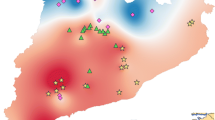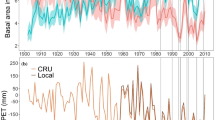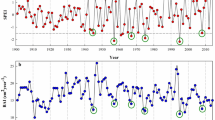Abstract
Global climate change is expected to increase the frequency and intensity of extreme droughts. Researching tree growth responses to drought helps assess the potential of forest adaptation and ecological stability under changing climate conditions. Here, we investigated tree growth resilience components (resistance, recovery, and resilience) to extreme drought events of two mainly distributed species, Pinus tabulaeformis and Picea wilsonii, on the Gannan Plateau, the Eastern Tibetan Plateau. Tree-ring width data from 510 trees at 20 plots along the elevation gradients were employed to analyze the tree resilience components at the individual tree level. The results showed that P. tabulaeformis had a lower growth resistance and a higher recovery capacity to drought than P. wilsonii, which might be related to the different strategies for combating drought of the two species. In addition, the tree growth response of P. tabulaeformis to drought changed significantly along the elevation gradient due to its higher drought sensitivity than that of P. wilsonii. Overall, the long-term correlation between tree growth and drought index, tree size, and soil water content had implications for tree growth resistance, recovery, and resilience. Given the observed differences in tree growth resistance to drought among different species and environmental conditions, a well-thought-out and tailored strategy would better support forest management on the Gannan Plateau.






Similar content being viewed by others
Availability of data and materials
The datasets used or analyzed during the current study are available from the corresponding author on reasonable request.
Code availability
Not applicable.
References
Adams HD, Zeppel MJB, Anderegg WRL et al (2017) A multi-species synthesis of physiological mechanisms in drought-induced tree mortality. Nat Ecol Evol 1:1285–1291. https://doi.org/10.1038/s41559-017-0248-x
Allen CD, Macalady AK, Chenchouni H et al (2010) A global overview of drought and heat-induced tree mortality reveals emerging climate change risks for forests. For Ecol Manag 259:660–684. https://doi.org/10.1016/j.foreco.2009.09.001
Allen CD, Breshears DD, McDowell NG (2015) On underestimation of global vulnerability to tree mortality and forest die-off from hotter drought in the Anthropocene. Ecosphere 6:1–55. https://doi.org/10.1890/ES15-00203.1
Anderegg WRL, Schwalm C, Biondi F et al (2015) Pervasive drought legacies in forest ecosystems and their implications for carbon cycle models. Science 349:528–532. https://doi.org/10.1126/science.aab1833
Anderegg WRL, Trugman AT, Badgley G et al (2020) Divergent forest sensitivity to repeated extreme droughts. Nat Clim Change 10:1091–1095. https://doi.org/10.1038/s41558-020-00919-1
Anderegg WRL, Wu C, Acil N et al (2022) A climate risk analysis of Earth’s forests in the 21st century. Science 377:1099–1103. https://doi.org/10.1126/science.abp9723
Andrews CM, D’Amato AW, Fraver S et al (2020) Low stand density moderates growth declines during hot droughts in semi-arid forests. J Appl Ecol 57:1089–1102. https://doi.org/10.1111/1365-2664.13615
Bennett AC, McDowell NG, Allen CD, Anderson-Teixeira KJ (2015) Larger trees suffer most during drought in forests worldwide. Nat Plants 1:15139. https://doi.org/10.1038/nplants.2015.139
Bhusal N, Lee M, Lee H et al (2021) Evaluation of morphological, physiological, and biochemical traits for assessing drought resistance in eleven tree species. Sci Total Environ 779:146466. https://doi.org/10.1016/j.scitotenv.2021.146466
Bohner T, Diez J (2021) Tree resistance and recovery from drought mediated by multiple abiotic and biotic processes across a large geographic gradient. Sci Total Environ 789:147744. https://doi.org/10.1016/j.scitotenv.2021.147744
Bunn AG (2010) Statistical and visual crossdating in R using the dplR library. Dendrochronologia 28:251–258. https://doi.org/10.1016/j.dendro.2009.12.001
Deng Y, Gou X, Gao L et al (2016) Tree-ring recorded drought variability in the northern Min Mountains of northwestern China: drought reconstruction in the northern Min Mountains. Int J Climatol 36:3550–3560. https://doi.org/10.1002/joc.4575
DeSoto L, Cailleret M, Sterck F et al (2020) Low growth resilience to drought is related to future mortality risk in trees. Nat Commun 11:545. https://doi.org/10.1038/s41467-020-14300-5
Ding H, Pretzsch H, Schütze G, Rötzer T (2017) Size-dependence of tree growth response to drought for Norway spruce and European beech individuals in monospecific and mixed-species stands. Plant Biol 19:709–719. https://doi.org/10.1111/plb.12596
Fang O, Zhang Q (2019) Tree resilience to drought increases in the Tibetan Plateau. Glob Change Biol 25:245–253. https://doi.org/10.1111/gcb.14470
FAO (2020) Global forest resources assessment 2020-key findings. FAO, Rome
Gazol A, Camarero JJ, Anderegg WRL, Vicente-Serrano SM (2017) Impacts of droughts on the growth resilience of Northern Hemisphere forests: forest growth resilience to drought. Glob Ecol Biogeogr 26:166–176. https://doi.org/10.1111/geb.12526
González de Andrés E, Rosas T, Camarero JJ, Martínez-Vilalta J (2021) The intraspecific variation of functional traits modulates drought resilience of European beech and pubescent oak. J Ecol 109:3652–3669. https://doi.org/10.1111/1365-2745.13743
Grossiord C (2020) Having the right neighbors: how tree species diversity modulates drought impacts on forests. New Phytol 228:42–49. https://doi.org/10.1111/nph.15667
Gupta A, Rico-Medina A, Caño-Delgado AI (2020) The physiology of plant responses to drought. Science 368:266–269. https://doi.org/10.1126/science.aaz7614
Holl KD, Brancalion PHS (2020) Tree planting is not a simple solution. Science 368:580–581. https://doi.org/10.1126/science.aba8232
Holmes RL (1983) Computer-assisted quality control in tree-ring dating and measurement. Tree-Ring Bull 43:51–67
Keen RM, Voelker SL, Wang S-YS et al (2022) Changes in tree drought sensitivity provided early warning signals to the California drought and forest mortality event. Glob Change Biol 28:1119–1132. https://doi.org/10.1111/gcb.15973
Li B, Zhang X, Morita S et al (2022) Are crop deep roots always beneficial for combating drought: a review of root structure and function, regulation and phenoty**. Agric Water Manag 271:107781. https://doi.org/10.1016/j.agwat.2022.107781
Liang E, Leuschner C, Dulamsuren C et al (2016) Global warming-related tree growth decline and mortality on the north-eastern Tibetan plateau. Clim Change 134:163–176. https://doi.org/10.1007/s10584-015-1531-y
Lloret F, Keeling EG, Sala A (2011) Components of tree resilience: effects of successive low-growth episodes in old ponderosa pine forests. Oikos 120:1909–1920. https://doi.org/10.1111/j.1600-0706.2011.19372.x
Martin-StPaul N, Delzon S, Cochard H (2017) Plant resistance to drought depends on timely stomatal closure. Ecol Lett 20:1437–1447. https://doi.org/10.1111/ele.12851
McDowell N, Pockman WT, Allen CD et al (2008) Mechanisms of plant survival and mortality during drought: why do some plants survive while others succumb to drought? New Phytol 178:719–739. https://doi.org/10.1111/j.1469-8137.2008.02436.x
McDowell NG, Allen CD, Anderson-Teixeira K et al (2020) Pervasive shifts in forest dynamics in a changing world. Science 368:eaaz9463. https://doi.org/10.1126/science.aaz9463
Nakagawa S, Johnson PCD, Schielzeth H (2017) The coefficient of determination R2 and intra-class correlation coefficient from generalized linear mixed-effects models revisited and expanded. J R Soc Interface 134:20170213. https://doi.org/10.1098/rsif.2017.0213
Palta JA, Turner NC (2019) Crop root system traits cannot be seen as a silver bullet delivering drought resistance. Plant Soil 439:31–43. https://doi.org/10.1007/s11104-018-3864-6
Pan Y, Birdsey RA, Fang J et al (2011) A large and persistent carbon sink in the world’s forests. Science 333:988–993. https://doi.org/10.1126/science.1201609
Peltier DMP, Ogle K (2020) Tree growth sensitivity to climate is temporally variable. Ecol Lett 23:1561–1572. https://doi.org/10.1111/ele.13575
Phillips NG, Ryan MG, Bond BJ et al (2003) Reliance on stored water increases with tree size in three species in the Pacific Northwest. Tree Physiol 23:237–245. https://doi.org/10.1093/treephys/23.4.237
Pretzsch H, Biber P, Schütze G et al (2014) Forest stand growth dynamics in Central Europe have accelerated since 1870. Nat Commun 5:4967. https://doi.org/10.1038/ncomms5967
Rozas V, Sampedro L, Vázquez-González C et al (2020) Site conditions exert more control than genetic differentiation on modulation of secondary growth and climate sensitivity of Pinus pinaster. Dendrochronologia 63:125732. https://doi.org/10.1016/j.dendro.2020.125732
Schweingruber FH, Eckstein D, Serre-Bachet F, Bräker OU (1990) Identification, presentation and interpretation of event years and pointer years in dendrochronology. Dendrochronologia 8:9–38
Serra-Maluquer X, Gazol A, Anderegg WRL et al (2022) Wood density and hydraulic traits influence species’ growth response to drought across biomes. Glob Change Biol 28:3871–3882. https://doi.org/10.1111/gcb.16123
Stovall AEL, Shugart H, Yang X (2019) Tree height explains mortality risk during an intense drought. Nat Commun 10:4385. https://doi.org/10.1038/s41467-019-12380-6
The R Core Team (2023) R: A language and environment for statistical computing. MSOR Connect
Trouillier M, van der Maaten-Theunissen M, Scharnweber T et al (2019) Size matters: a comparison of three methods to assess age—and size-dependent climate sensitivity of trees. Trees 33:183–192. https://doi.org/10.1007/s00468-018-1767-z
van der Maaten-Theunissen M, Trouillier M, Schwarz J et al (2021) pointRes 2.0: new functions to describe tree resilience. Dendrochronologia 70:125899. https://doi.org/10.1016/j.dendro.2021.125899
Vicente-Serrano SM, Beguería S, López-Moreno JI (2010) A multiscalar drought index sensitive to global warming: the standardized precipitation evapotranspiration index. J Clim 23:1696–1718. https://doi.org/10.1175/2009JCLI2909.1
Vitali V, Büntgen U, Bauhus J (2017) Silver fir and Douglas fir are more tolerant to extreme droughts than Norway spruce in south-western Germany. Glob Change Biol 23:5108–5119. https://doi.org/10.1111/gcb.13774
Wang J, Fu B, Lu N, Zhang L (2017) Seasonal variation in water uptake patterns of three plant species based on stable isotopes in the semi-arid Loess Plateau. Sci Total Environ 609:27–37. https://doi.org/10.1016/j.scitotenv.2017.07.133
Wang F, Zhang F, Gou X et al (2021a) Seasonal variations in leaf-level photosynthesis and water use efficiency of three isohydric to anisohydric conifers on the Tibetan Plateau. Agric For Meteorol 308–309:108581. https://doi.org/10.1016/j.agrformet.2021.108581
Wang X, Chen D, Pang G et al (2021b) Historical and future climates over the upper and middle reaches of the Yellow River Basin simulated by a regional climate model in CORDEX. Clim Dyn 56:2749–2771. https://doi.org/10.1007/s00382-020-05617-4
Wang B, Chen T, Li C et al (2022) Discrepancy in growth resilience to drought among different stand-aged forests declines going from a semi-humid region to an arid region. For Ecol Manag 511:120135. https://doi.org/10.1016/j.foreco.2022.120135
Wu Z, Raven PH (1999) Flora of China, vol 4, Cycadaceae-Fagaceae. Missouri Botanical Garden Press
Zang C, Pretzsch H, Rothe A (2012) Size-dependent responses to summer drought in Scots pine, Norway spruce and common oak. Trees 26:557–569. https://doi.org/10.1007/s00468-011-0617-z
Zang C, Hartl-Meier C, Dittmar C et al (2014) Patterns of drought tolerance in major European temperate forest trees: climatic drivers and levels of variability. Glob Change Biol 20:3767–3779. https://doi.org/10.1111/gcb.12637
Zhang X, Fan Z, Shi Z et al (2022) Tree characteristics and drought severity modulate the growth resilience of natural Mongolian pine to extreme drought episodes. Sci Total Environ 830:154742. https://doi.org/10.1016/j.scitotenv.2022.154742
Funding
This work was funded by the Second Tibetan Plateau Scientific Expedition and Research Program (2019QZKK0301), the Joint Funds of the National Natural Science Foundation of China (U21A2006), and by the 111 project (BP0618001).
Author information
Authors and Affiliations
Contributions
DCY carried out conceptualization, writing original draft, and investigation. XHG performed supervision; reviewing and editing; and funding acquisition. HJY collected data and analysis. KW collected data and analysis. DYZ collected data and analysis.
Corresponding author
Ethics declarations
Conflicts of interest
The authors declare no competing interests are relevant to this article.
Additional information
Communicated by Miren del Río.
Publisher's Note
Springer Nature remains neutral with regard to jurisdictional claims in published maps and institutional affiliations.
Supplementary Information
Below is the link to the electronic supplementary material.
Rights and permissions
Springer Nature or its licensor (e.g. a society or other partner) holds exclusive rights to this article under a publishing agreement with the author(s) or other rightsholder(s); author self-archiving of the accepted manuscript version of this article is solely governed by the terms of such publishing agreement and applicable law.
About this article
Cite this article
Yin, D., Gou, X., Yang, H. et al. Species-specific, size-dependent, and environmentally modulated growth resilience to drought in conifer forests on the Eastern Tibetan Plateau. Eur J Forest Res 143, 33–43 (2024). https://doi.org/10.1007/s10342-023-01604-6
Received:
Revised:
Accepted:
Published:
Issue Date:
DOI: https://doi.org/10.1007/s10342-023-01604-6




